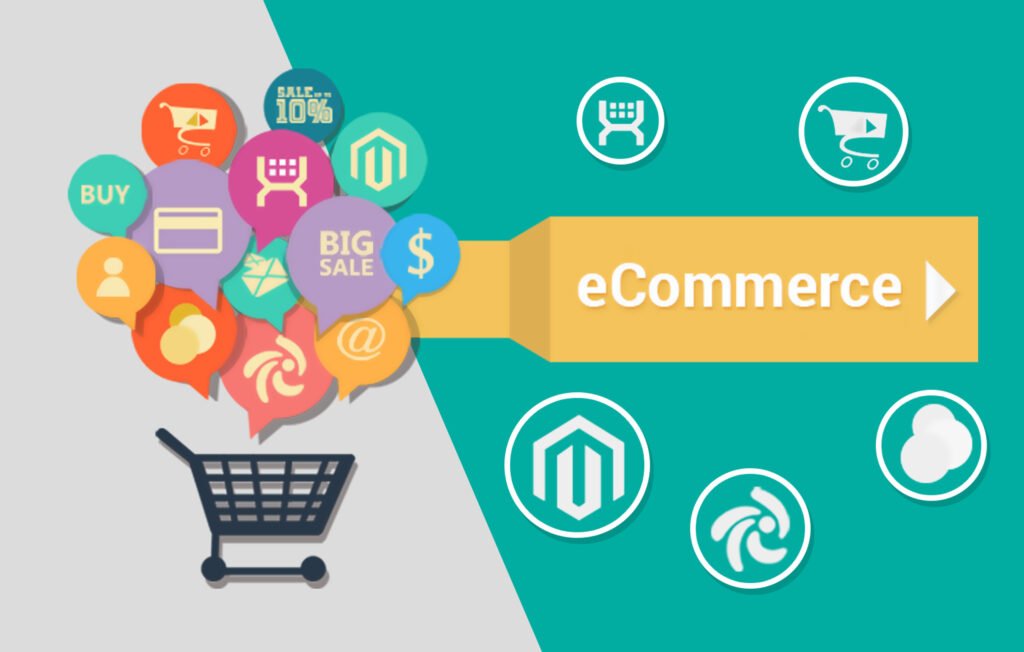E-commerces Marketing In today’s highly competitive digital marketplace, e-commerces businesses need to leverage effective marketing strategies to stand out, drive traffic, and increase sales. Whether you’re just starting out or have been in the industry for years, understanding and implementing the right e-commerce marketing techniques can significantly improve your online presence and profitability.
This article will explore some of the top e-commerce marketing techniques that can help you drive more traffic to your store, increase conversions, and ultimately grow your sales.
Key Takeaways
- Implement a holistic approach: Use a combination of SEO, social media, content, email, and influencer marketing to drive traffic and increase sales.
- Personalization is key: Tailor your marketing messages to specific customer segments for better engagement and conversion.
- Monitor and optimize: Continuously track the performance of your marketing campaigns and adjust your strategies accordingly to ensure maximum ROI.
- Build long-term relationships: E-commerce marketing is not just about making a sale; it’s about creating an ongoing relationship with your customers to encourage repeat purchases.
Why is E-commerces Marketing Important?

E-commerce marketing is crucial because it helps online businesses connect with their target audience, build brand awareness, and influence purchasing decisions. In a world where consumers are constantly browsing, comparing, and purchasing products online, effective marketing strategies are essential for attracting and retaining customers.
By implementing a range of marketing techniques, e-commerce businesses can enhance the shopping experience for their customers, build long-term relationships, and optimize their sales funnels to maximize conversion rates.
Search Engine Optimization (SEO) for E-commerce Websites
What is SEO and Why is It Important?
SEO, or Search Engine Optimization, is the process of optimizing your website to rank higher on search engine results pages (SERPs). The goal of SEO is to increase organic (non-paid) traffic to your e-commerce store. SEO plays a critical role in ensuring your products and services are visible to potential customers when they search for related terms.
SEO, or Search Engine Optimization, is the practice of enhancing a website to improve its visibility on search engines like Google, Bing, and Yahoo. It involves optimizing various elements of a website to ensure that it ranks higher in search engine results pages (SERPs) when users search for relevant terms. The ultimate goal of SEO is to increase organic traffic to a website, which can lead to greater exposure, more leads, and increased sales.
SEO is not a one-time task; it is an ongoing process that requires continuous monitoring, adaptation, and improvement to stay ahead of competitors and changes in search engine algorithms.
Key Elements of SEO:
On-Page SEO: This includes all the elements of a website that can be optimized directly on the page. On-page SEO focuses on making sure your content, HTML tags, and media (like images and videos) are optimized for search engines. Key components include:
- Keyword Optimization: Including relevant search terms within your page content, meta descriptions, headers, and image alt text.
- Content Quality: Creating high-quality, valuable, and informative content that matches the search intent of users.
- URL Structure: Ensuring that URLs are clean, descriptive, and contain relevant keywords.
- Internal Linking: Linking to other pages within your website to create a logical site structure and improve navigation.
- Mobile Friendliness: Ensuring that your website is optimized for mobile users, as search engines prioritize mobile-first websites.
Off-Page SEO: Off-page SEO focuses on external factors that can influence your website’s search ranking. It mainly revolves around backlinks, which are links from other websites pointing to your own. Quality backlinks signal to search engines that your content is trustworthy and authoritative. Building relationships, guest blogging, and promoting content on social media are common off-page SEO tactics.
Technical SEO: Technical SEO involves optimizing the backend structure of your website to ensure search engines can crawl and index it efficiently. Key technical SEO elements include:
- Website Speed: Ensuring fast loading times for a better user experience and search engine ranking.
- Site Architecture: Structuring your site in a logical way so that search engines can easily crawl it.
- XML Sitemaps: Providing search engines with a map of your website’s structure to help them index your content.
- Secure Website (HTTPS): Using HTTPS to ensure a secure connection, which is a ranking factor for Google.
Local SEO: Local SEO focuses on optimizing your online presence to rank higher in local search results. This includes creating and optimizing a Google My Business profile, getting local reviews, and ensuring consistent NAP (Name, Address, Phone Number) information across directories.
Why is SEO Important?
Increased Visibility and Traffic: When your website ranks higher on SERPs, it becomes more visible to users searching for relevant products, services, or information. Higher visibility leads to more website traffic, which translates into more opportunities for conversions, sales, and leads.
Cost-Effective Marketing: SEO is one of the most cost-effective marketing strategies available. Unlike paid ads where you need to continuously invest, SEO generates organic traffic that doesn’t incur a per-click cost. While it may take time to see results, the long-term benefits of SEO can deliver a higher return on investment (ROI) compared to paid campaigns.
Credibility and Trust: Websites that appear on the first page of search results are typically perceived as more credible and trustworthy by users. Ranking high for relevant search queries positions your website as an authoritative source in your industry, which helps build customer trust.
Better User Experience: SEO isn’t just about making search engines happy; it’s also about improving the user experience. A well-optimized website with easy navigation, fast load times, and relevant content makes it easier for visitors to find what they need, improving the likelihood of conversion.
How to Implement SEO for E-commerce Websites:
- Keyword Research: Identify the keywords and phrases that your target audience is searching for. Use tools like Google Keyword Planner, SEMrush, or Ahrefs to find high-ranking keywords.
- Optimize Product Pages: Include the main keyword in your product titles, descriptions, and image alt texts.
- Content Creation: Publish blog posts or guides related to your products or industry. Content marketing can drive traffic and improve SEO by targeting long-tail keywords.
- Technical SEO: Ensure your website loads quickly, is mobile-friendly, and has a clear URL structure. Google rewards fast-loading websites with better rankings.
- Backlink Building: Obtain backlinks from high-authority websites to boost your site’s credibility and search engine rankings.
By implementing a strong SEO strategy, you can increase your visibility on search engines, which in turn leads to more organic traffic and higher sales.
Pay-Per-Click (PPC) Advertising
| Aspect | Description |
|---|---|
| Definition | Pay-Per-Click (PPC) is a form of digital advertising where businesses pay each time a user clicks on their ad. |
| Platforms | Common platforms for PPC campaigns include Google Ads, Bing Ads, Facebook Ads, and Instagram Ads. |
| Targeting Options | PPC allows for precise targeting based on keywords, demographics, location, interests, and browsing behaviors. |
| Types of PPC Ads | Includes search ads (text), display ads (banners), video ads, and shopping ads, each serving different purposes. |
| Budget Control | You can set daily or campaign budgets and adjust bids for different keywords, ensuring control over your spend. |
| Bidding Strategy | Common strategies include manual bidding (set bid amounts) and automated bidding (Google adjusts bids for optimization). |
| Ad Rank | Ads are ranked based on a combination of bid amount, ad quality, and relevance to the search query. |
| Quality Score | A metric used by Google Ads to determine ad placement and cost; it’s based on click-through rate (CTR), relevance, and landing page quality. |
| Retargeting | PPC ads can target users who have previously visited your site but didn’t convert, encouraging them to return and complete a purchase. |
| Performance Metrics | Key metrics to track include Cost Per Click (CPC), Click-Through Rate (CTR), Conversion Rate, and Return on Investment (ROI). |
| Advantages | Immediate traffic, precise targeting, measurable results, and the ability to test and optimize campaigns in real time. |
| Challenges | High competition for popular keywords, the cost of clicks can add up, and effective management requires ongoing optimization. |
What is PPC and How Does It Work?
PPC is a form of online advertising where you pay each time someone clicks on one of your ads. Google Ads and Facebook Ads are two of the most popular platforms for PPC campaigns. PPC allows businesses to target specific audiences based on factors such as demographics, location, and behavior.
How to Implement PPC for E-commerce Stores:
- Targeted Campaigns: Use Google Ads or Facebook Ads to run targeted campaigns based on search terms related to your products. This ensures you reach potential customers at the right time.
- A/B Testing: Test different ad copy, images, and landing pages to determine which combinations perform best.
- Retargeting: Retarget users who have previously visited your website but didn’t make a purchase. This keeps your brand top-of-mind and encourages them to return and complete the purchase.
- Budget Optimization: Monitor your campaigns regularly and adjust your budget based on performance to maximize return on investment (ROI).
PPC is a fast and effective way to drive targeted traffic to your e-commerce site, especially if you’re looking to generate quick sales.
Social Media Marketing

Why is Social Media Marketing Essential for E-commerce?
Social media platforms like Instagram, Facebook, TikTok, and Pinterest offer businesses the opportunity to showcase their products, engage with customers, and drive traffic to their websites. Social media marketing is a cost-effective way to build brand awareness and connect with potential buyers.
How to Implement Social Media Marketing for E-commerce:
- Choose the Right Platforms: Focus on platforms where your target audience spends the most time. For example, Instagram and Pinterest are great for visually appealing products, while LinkedIn might work better for B2B e-commerce businesses.
- Engagement and Community Building: Engage with your audience by responding to comments, reposting user-generated content, and hosting giveaways or contests. Building a loyal community on social media helps improve brand loyalty and trust.
- Paid Social Ads: Use paid ads on social media platforms to target specific audience segments. For instance, Instagram and Facebook ads allow you to create highly targeted campaigns based on user interests and behaviors.
- Influencer Marketing: Partner with influencers or industry leaders who have a significant following in your niche. Influencers can promote your products to their audience, driving both traffic and sales.
Social media marketing can be a powerful tool for increasing your e-commerce store’s visibility and driving traffic from highly engaged audiences.
Email Marketing
How Can Email Marketing Help Drive Sales?
Email marketing remains one of the most effective ways to communicate directly with your customers and drive sales. By sending personalized and targeted messages, you can encourage customers to return to your store, complete abandoned purchases, or check out new product offerings.
How to Implement Email Marketing for E-commerce:
- Build an Email List: Offer incentives like discounts or free shipping to encourage website visitors to subscribe to your email list.
- Segment Your Email List: Create different email segments based on customer behaviors, such as first-time buyers, repeat customers, or those who abandoned their shopping carts.
- Personalized Email Campaigns: Send personalized product recommendations, special offers, or reminders about items left in the cart.
- Automated Workflows: Set up automated email workflows for key moments in the customer journey, such as welcome emails, abandoned cart emails, or post-purchase follow-up emails.
- A/B Testing: Test different email subject lines, designs, and CTAs (calls to action) to optimize your email campaigns.
Email marketing is a great way to nurture relationships with customers and turn one-time buyers into loyal, repeat customers.
Influencer and Affiliate Marketing

What is Influencer and Affiliate Marketing?
Influencer and affiliate marketing allow businesses to leverage the reach and credibility of third-party individuals or companies to promote products. Influencers promote products to their audience, while affiliates earn a commission on sales generated through their referral links.
How to Implement Influencer and Affiliate Marketing for E-commerce:
- Find the Right Influencers: Look for influencers who align with your brand values and have an engaged following in your niche.
- Create Clear Terms: Establish clear terms and agreements with influencers or affiliates regarding compensation, deliverables, and content guidelines.
- Track Sales and Performance: Use affiliate marketing software to track sales and commissions, ensuring transparency and proper compensation for affiliates.
- Use Multiple Influencers: Diversify your influencer marketing efforts by working with influencers at different levels (macro, micro, nano) to reach a wider audience.
Influencer and affiliate marketing can help you tap into new customer bases and increase brand credibility, ultimately driving more traffic and sales.
Content Marketing and Blogging

Why is Content Marketing Important?
Content marketing is a powerful way to educate, engage, and persuade your audience. By creating valuable, informative, and entertaining content, you can build brand awareness, improve SEO, and establish yourself as an authority in your industry.
How to Implement Content Marketing for E-commerce:
- Create Engaging Blog Posts: Write blog posts that are relevant to your audience. For example, how-to guides, product reviews, or industry trends can provide value while also showcasing your products.
- Use SEO to Optimize Content: Incorporate keywords into your blog content to ensure it ranks well on search engines, driving organic traffic to your site.
- Leverage Visual Content: Incorporate videos, infographics, and images into your content to make it more engaging and shareable on social media.
- Guest Posting: Write guest posts for other websites or collaborate with influencers to promote your content, driving traffic back to your e-commerce store.
Content marketing can boost your website’s visibility, establish credibility, and encourage customer engagement, ultimately driving more sales.
Also Read : The Ultimate Guide To E-commerce Marketing: Best Practices For Success
Conclusion
E-commerce marketing is a multifaceted approach that requires a combination of strategies to effectively drive traffic and boost sales. By using SEO, PPC, social media marketing, email marketing, and influencer marketing, you can attract new customers, engage your audience, and turn one-time visitors into loyal buyers. The key to success in e-commerce marketing is to stay adaptable, continually optimize your strategies, and focus on providing value to your customers.
FAQs About E-commerce Marketing
What is the best way to drive traffic to my e-commerce website?
The best ways to drive traffic to your e-commerce website are through SEO, paid advertising (PPC), social media marketing, and content marketing. A combination of these techniques is usually the most effective.
How important is SEO for e-commerce?
SEO is critical for e-commerce because it helps increase organic traffic, boosts visibility in search engines, and drives more potential customers to your website.
How can social media marketing help my e-commerce store?
Social media marketing helps build brand awareness, engage with potential customers, and drive traffic to your website by sharing product updates, promotions, and content.
What is influencer marketing, and how can it help my business?
Influencer marketing involves partnering with individuals who have a strong following on social media. They promote your products to their audience, which can help increase brand visibility and drive sales.
How can I use email marketing to increase sales?
Email marketing allows you to send personalized offers, product recommendations, and reminders about abandoned carts, which can motivate customers to complete their purchases.
What is affiliate marketing in e-commerce?
Affiliate marketing involves partnering with affiliates who promote your products in exchange for a commission on the sales generated through their referral links.
What is the role of content marketing in e-commerce?
Content marketing helps attract, educate, and engage customers through valuable content like blog posts, videos, and infographics. This can drive traffic, improve SEO, and increase conversions.



